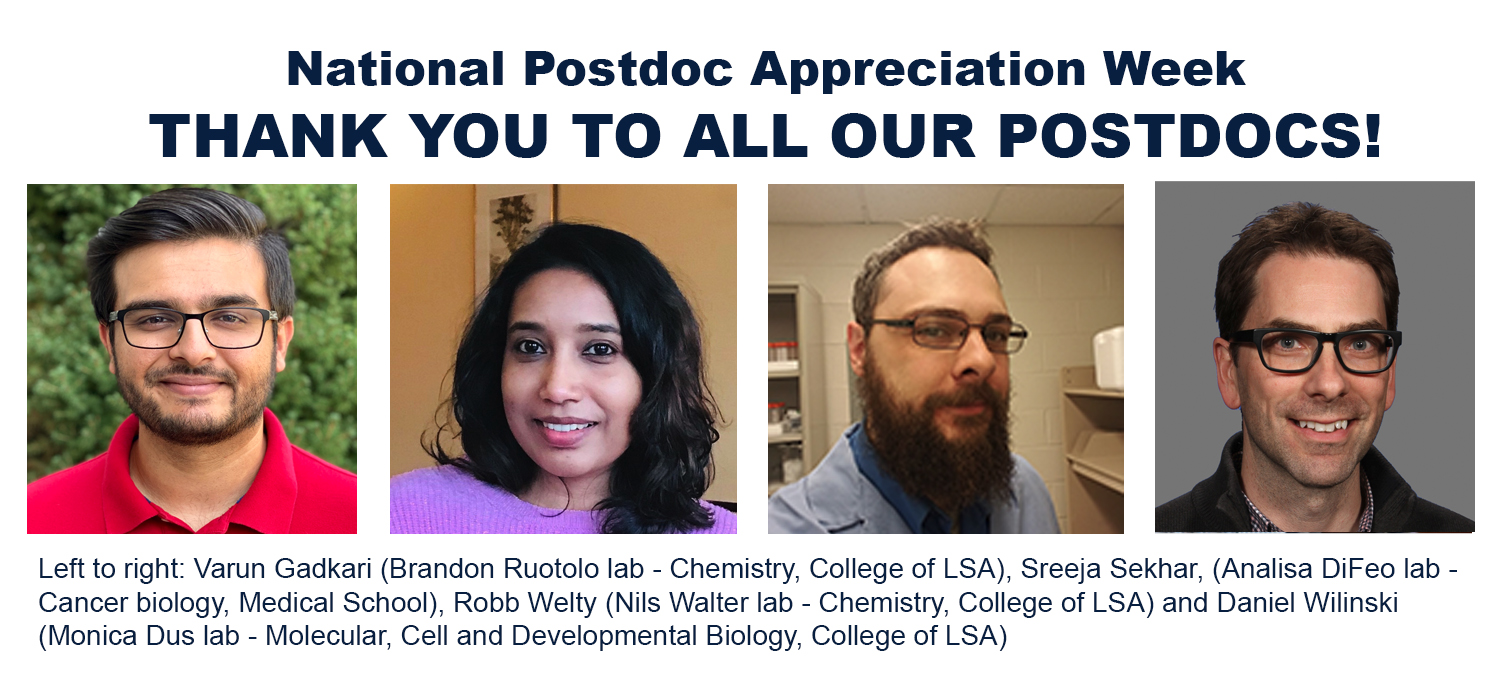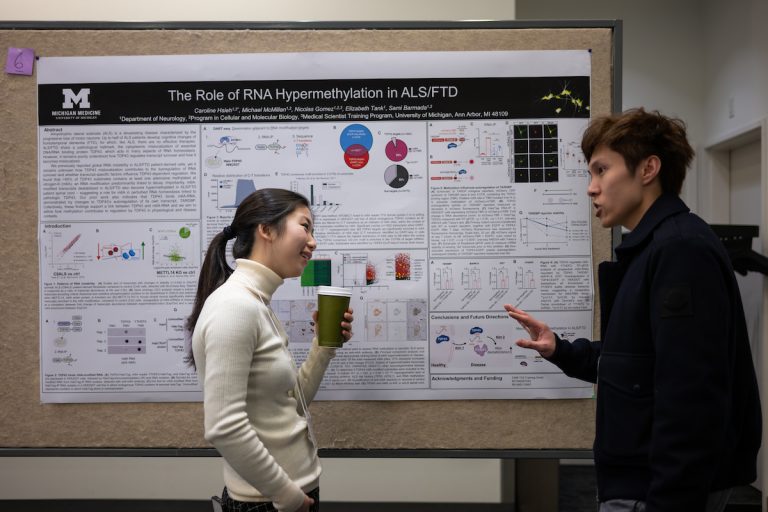Thank you to our postdocs!

On the occasion of the National Postdoc Appreciation Week, September 21st–25th, the University of Michigan (U-M) Center for RNA Biomedicine’s community warmly thanks UM’s postdocs for their tremendous contributions to the field of RNA research and to the life of our scientific community.
According to the U-M Postdoctoral Association (UMPDA), an estimated 1,400 to 1,600 postdocs work across the University. They are key contributors to U-M’s research endeavor and to the dynamics of our labs. To thank them all, we interviewed four of them, all passionate about their research and lab work, representative of the entire cohort. Here is a summary of what they had to say about their roles at the U-M.
Postdocs bring their unique experience and passion for scientific investigations to U-M labs. They all have remarkable trajectories, having often traveled across the country several times and internationally to work with leading scientists. They are curious and relentless explorers who want to make a difference through biological discoveries that will transform lives.
For example, Daniel Wilinski first studied malaria after he contracted the disease in Tanzania. “One million people die every year from malaria,” he reminds us. Wilinski was determined “to study something that has a clear public health implication.” He most recently switched to working on diabetes in Monica Dus’ lab in Molecular, Cellular and Developmental Biology of the College of Literature, Science and the Arts (LSA). “Diabetes is an increasingly devastating condition, and several close members of my family are suffering from it. I’m very motivated to help out.”
Sreeja Sekhar, a postdoc in Analisa DiFeo’s lab of Cancer Biology in the Medical School, studied undergraduate biology at Mahatma Gandhi University in southern India, and did her doctorate at Okayama University in Japan through the highly competitive MEXT Japanese Government Scholarship, offered to only 30 Indian scholars per year from all scientific fields. She is very enthusiastic about the oncogenic micro-RNA research she is conducting at U-M. She is also quite eager to learn more about the many clinical trials that are ongoing at UM in the field of cancer research. “These trials are very important in advancing our current therapeutics. Also, as researchers, it is very motivating to contribute our part to the community,” she says. Accordingly, Robb Welty, a postdoc in Nils Walter’s lab in Chemistry of the College of LSA feels that “postdocs have an impact on the society we live in, and take on a great responsibility.”
As postdocs often have received extensive training at other institutions, they also bring entirely new approaches and technical skills to UM. They facilitate cross-pollinations and share new ideas that they have acquired and incubated in other labs, opening up entirely new research directions. “Postdocs keep learning and evolving,” says Sekhar. “Postdocs maintain the excitement of doing research in a lab!” adds Wilinski.
Postdocs in academia enjoy the freedom to investigate new ideas and experiments. They thrive with their PI’s support and willingness to investigate. “My PI is always open to new ideas,” says Gadkari, a postdoc in Brandon Ruotolo’s lab in Chemistry of the College of LSA. “The person a postdoc works with has an enormous influence on their life,” adds Wilinksi, and Welty further explains that “there is a strong partnership between PI and postdoc.”
Postdocs also mentor graduate students, helping them develop their own experiments and showing them new techniques. “I’m always glad to help the students in my lab, to take load off my advisor,” says Gadkari. “He does not need to be in the lab all the time because I can help students with smaller, day-to-day experimental or technical issues.” Through their postdoc experience, these scientists prepare for founding their own labs, learning to be mentors and becoming leaders in their fields.
At the U-M, postdocs have found a remarkable community of colleagues who share their breadth and depth of expertise, and “are genuinely interested in each other’s work, supporting one another,” says Wilinski. “However, it can be difficult to find the people who have the same interests, and this is why it is great to have the Center for RNA Biomedicine.” The Center’s mission is to facilitate the exchange of ideas and scientific discussions. Wilinski is one of the founders of the RNA Student and Postdoc Council’s Journal Club that meets to discuss articles by seminar series’ presenters. He enjoys the scientific exchanges that happen during these meetings. Sekhar, who recently joined the Student & Postdoc Council, is looking forward to learning from her peers and sharing skills. For Welty, the Council and the Center are great platforms to network and to learn about the RNA community.
The University of Michigan’s Postdoctoral Association (UMPDA) and other support structuresGadkari is on the board of UMPDA, a volunteer organization dedicated to provide career development and networking opportunities for postdoctoral fellows throughout their time at the U-M and beyond. Gadkari explains that UMPDA’s mission is to “represent the interests of, and address issues faced by, postdoctoral fellows and their families at the University of Michigan.”. Like other large research institutions, the U-M has an office with postdoc-focused administrative staff and offers other broad opportunities for them through the Rackham Graduate School. We strongly encourage you to seek out these resources.
How to choose a postdoc lab?
Choosing a mentor to join is an important endeavor. Our postdocs give several pieces of advice. When he was looking for a postdoc lab, Welty established a list of criteria, and found out that only four labs in the US met those. He also recommends to make sure that the lab and institution have plenty of resources. This is important so the postdocs can fully experiment with what they’re researching. At the U-M, Welty found the SMART Center, one of the two core facilities of the Center for RNA Biomedicine. “It is an amazing place and it is very rare for a university to have such a facility! The SMART Center gives access to cutting edge microscope technologies, as well as to the extraordinary support of the SMART Center’s manager, Damon Hoff. He is extremely helpful with experimental methodology to give users the highest resolution possible. Damon is always willing to push the techniques to do very powerful experiments.”
Gadkari strongly suggests that seeking a postdoc is a new beginning from one’s graduate experience. “There is a new excitement about being in a lab and doing a new research project. There is much freedom, you don’t need to know exactly what you want to do. It’s a wonderful time to learn new techniques and develop new ideas, and the U-M is a great place for it,” he explains.
For Sekhar, “choosing an inspiring mentor who motivates you is the first step, and a collaborative lab environment is also very important.” As for Wilinski, he recommends “to find a great mentor who is going to help in so many projects and aspects of your career. Also talk to people, especially those who have left the lab, and expect that one’s initial idea will change of what mentoring style is the best match as one grows into his or her career.” He concludes with the advice he received from his mentor: “Go to the lab that has the happiest people!”
Postdocs are quite unique and essential to the life of our labs. They keep the passion and excitement of discoveries alive, and we’re very grateful for and celebrate them at the U-M!
Thank you from the Center for RNA Biomedicine!

